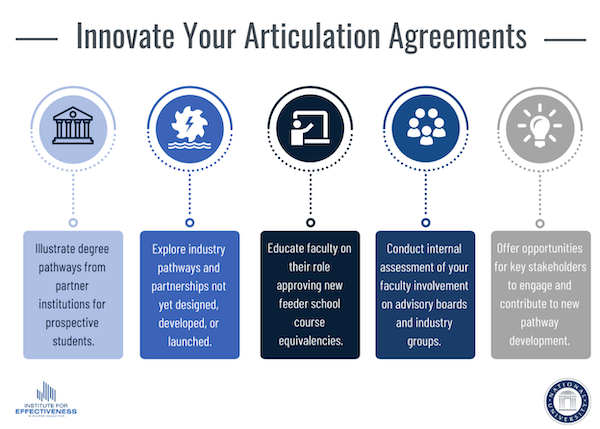Published on
Fostering Innovative Articulation Agreements to Support Transfer Students

Improving your existing articulation agreements bolsters transfer-in enrollments, student experiences as well as student success.
Over 30% of undergraduate students transfer colleges. And that was before the pandemic. Even more students are expected to transfer colleges as they reevaluate what they want (e.g., proximity from home, a different major, lower cost, etc.). And those increases are in addition to the students who planned to transfer after completing their associate degree. In short, serving transfer students needs to be high on the agenda for most colleges and universities.
How is your institution preparing for more transfer students?
The transfer-in processes and student success metrics of transfer-in students leave much to be desired. There is considerable room to innovate, collaborate, and capitalize on new opportunities. This article aims to prompt senior leaders to elevate their articulation agreements to a level that others want to emulate.
What exactly is an articulation agreement (and why is this an important topic)?
Articulation agreements are the formal documents that capture the agreed upon course equivalencies between institutions. The agreements make clear what credits the receiving institution will accept, which avoids any guesswork on the part of the transfer credit evaluator, since the institutions have already established these course equivalencies.
Aren’t articulation agreements unnecessary?
This is a common question. Many people think that articulation agreements are outdated and obsolete. Why should we have articulation agreements if our institution is already very transfer-in student credit-friendly?
These important agreements are not nearly as helpful for transfer students if they live in the dusty archives of your registrar’s record system. Transferring students waiting to hear whether their completed courses transfer after their transcripts are evaluated is not a recommended strategy to inspire confidence in your institution.
Beyond articulating the general education curriculum, institutions have the potential to be forward-looking and partner with transfer schools to provide intentional and clear academic pathways. Articulation agreements and course equivalencies should be accessible to both transfer students and program faculty. Knowing what your institution accepts as course equivalencies and sharing this information with your prospective transfer students can be life-changing. Students looking to transfer are relying on accurate advising and information on what will transfer as they prepare to make the transition. Collaborations between faculty across institutions can expand the options students have, reducing redundancy and time to completion at the four-year institution.
From dull to innovative articulation agreements
Senior leaders who really want to move the needle not only on enrollments but also student success should consider creating innovative articulation agreements. The Institute for Effectiveness in Higher Education (IEHE) has identified colleges and universities that are not only overperforming with transfer-in student success but also showcasing their transfer-in student supports online—including articulation agreements. In short, IEHE has done the heavy lifting research to identify the institutions and practices that are getting student success results.
To help expand your articulation agreements and strengthen the pathways you offer transfer-in students, we offer five practical tips.

1. Illustrate degree pathways from partner institutions for prospective students
Ask yourself, does your website clearly offer your institution’s degree pathways? If so, for which programs and from which schools. For example, see National University’s Cybersecurity Pathways, which is mapped for prospective students.
2. Explore industry pathways and partnerships
Explore these pathways and partnerships that have not yet been designed, developed, or launched—ones that are informed by workforce employment projections. Ask yourself what partnerships/pathways don’t exist for you right now but that could be quickly and/or efficiently established.
3. Educate faculty on their role approving new feeder school course equivalencies
Ask yourself what role deans and program leads take in approving course equivalencies, exceptions, and articulated agreements. Should or could faculty be more engaged in this process?
4. Conduct internal assessment
Assess your faculty involvement on advisory boards and industry groups that unite faculty across institutions based on degree program/industry/field. See if your department chairs or deans know the roles your faculty serve on at external organizations. Who holds such awareness information?
5. Involve key stakeholders in the conversation
Arrange opportunities for all key stakeholders to engage in the conversation for new pathway development. Ask yourself if program faculty and articulation officers communicate across institutions to review new pathway course equivalencies. Look to see who needs to be involved to initiate and coordinate meetings between your faculty and those at partner institutions.
The following suggestions may be a bit more obvious but worth ensuring, so that you have a solid foundational infrastructure to do the innovative work.
- Ensure your articulation officer is on a first name basis with the articulation officers at all feeder institutions.
- Cross-train faculty on registrar operations, course-equivalency systems, and course equivalencies from other institutions approved to transfer into their programs.
- Coordinate intentional curriculum review between institutions, reviewing updated courses and new potential course equivalencies for 100- and 200-level preparatory transfer courses.
- Update your transfer-equivalency system in real time with faculty-approved equivalencies.
- Understand residency and institutional requirements around maximum allowable transfer units at your school.
Next-level articulation agreements
Institutions aiming for next-level articulation agreements should consider developing agreements for programs and pathways prioritizing regional workforce needs. Yes, this does require some project management and collaboration. In the end, this should be the work in which we administrators take pride, knowing our efforts are serving transfer students, their families, and our community. Reducing both cost and time to completion for students is well worth the investment of significant effort.
Disclaimer: Embedded links in articles don’t represent author endorsement, but aim to provide readers with additional context and service.



